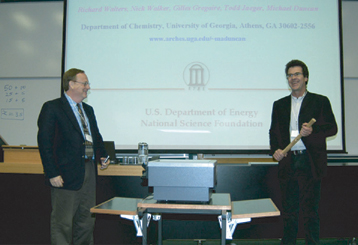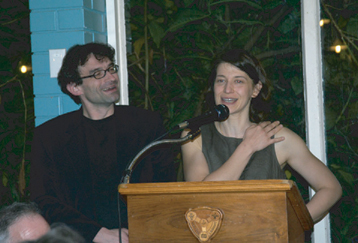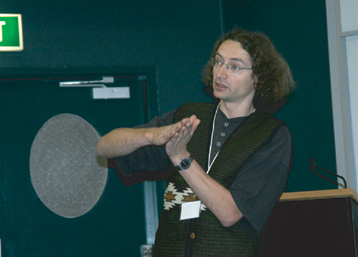Computational Chemistry and Spectroscopy
Brian F. Yates AA School of Chemistry, University of Tasmania, Hobart TAS 7001, Australia. Email: Brian.Yates@utas.edu.au

Following a PhD at the Australian National University, Brian Yates completed postdoctoral work at the University of California, Berkeley and the University of Georgia before taking up an academic position at the University of Tasmania in 1989. During his time in Hobart, Brian has built up a strong reputation in computational chemistry and established an active research group in this area, as well as fostering close collaborations with a number of experimental chemists. His research interests are broad and focus on computational and physical chemistry but with applications to organometallic and organic chemistry. He has a passionate enthusiasm for science and is currently chair of the Tasmanian Goverment’s Science and Technology Council. |
Australian Journal of Chemistry 57(12) 1117-1118 https://doi.org/10.1071/CH04231
Submitted: 3 September 2004 Accepted: 3 September 2004 Published: 8 December 2004
This special issue on computational chemistry and spectroscopy is drawn from highlights of the 2004 conference of the Physical Chemistry Division of the Royal Australian Chemistry Institute, held in Hobart during 1–5 February 2004 (Figs 1–3, all photos courtesy of Elmars Krausz). Attended by some 130 people it encompassed a diverse range of physical chemistry topics, from fundamental structural studies of small molecules through to complicated phenomena of proteins. This special issue of the Australian Journal of Chemistry is devoted to articles by researchers who attended the conference, with a particular focus on spectroscopy and computational chemistry. Roughly half the papers describe spectroscopic experiments and half describe computational studies, but at least several show a strong overlap between both areas.

|

|

|
With advances in laser technology and molecular beam techniques it is now possible to carry out spectroscopy on single molecules or complexes in the gas phase and this forms the basis for a series of articles in this issue. In the work described by Walters and Duncan,[1] they discuss the single photon photodissociation infrared spectra of weakly bound metal cation complexes prepared by laser vaporization in a pulsed-nozzle cluster source. Zehnacker and coworkers[2] report their use of laser-induced fluorescence to study chiral discrimination at the molecular level in jet-cooled complexes formed in supersonic expansions. A series of protonated molecular clusters formed from a similar corona-discharge supersonic expansion has been studied by Chang and coworkers[3] who characterized their infrared spectra by vibrational predissociation spectroscopy in combination with density functional theory. Vibrational predissociation spectroscopy and ab initio calculations have also been used to obtain the infrared spectra of gas phase halide–methane clusters as discussed in the paper by Bieske and coworkers.[4] Bahou and Lee[5] in their paper on time-resolved Fourier transform spectroscopy discuss the dissociation mechanism of vinyl chloride upon photolysis. The paper by Mafuné[6] describes how a liquid beam may be used in conjunction with laser multiphoton ionization mass spectroscopy to study the incomplete solvation of molecules on a liquid surface. The use of single molecule spectroscopy to observe the excited state behaviour of a rylene-based dye is described in the paper by De Schryver and coworkers.[7]
Many other spectroscopic techniques are currently providing important information in physical chemistry and examples of such studies are also provided in this issue. Some of the mechanisms of electronic energy transfer processes are discussed in the paper by Ghiggino and coworkers[8] and factors which are important in molecular design for optimizing energy transfer are highlighted. McNaughton and coworkers[9] in their paper describe how single-point mapping and focal plane array imaging may be used to record detailed Fourier transform infrared maps and images of tissue samples as a potential diagnostic tool for cervical cancer. The paper by Krausz and coworkers[10] reports well resolved low temperature optical spectra of photosystem II and analyzes the nature of the P680 reaction centre. Multinuclear NMR relaxation and pulsed field gradient spin echo diffusion measurements have been used by Price and coworkers[11] to determine the solution dynamics and nanoscale reorganization of polymer electrolytes in order to provide information for the further development of lithium batteries and related systems.
Density functional theory and quantum chemical calculations remain the foundation of many computational chemistry studies and this is exemplified in a series of papers in this issue. Lein and Frenking[12] describe their use of density functional theory calculations and energy partitioning analyses to study in detail the bonding interactions in two octahedral molecules. Coote[13] in her paper describes quantum chemical calculations aimed at understanding the detailed reaction mechanisms involved in reversible addition fragmentation chain transfer (RAFT) polymerization. The paper by Buntine and coworkers[14] describes their density functional theory calculations on the structures and properties of a series of metal tetramer clusters which are analogous to those which have been observed in the gas phase. In a wide-ranging article Reimers and coworkers[15] use theoretical methods to describe the transport of electrons within molecules, between molecules, and through molecules. The use of high-level theoretical techniques to calculate accurate aqueous pKa values is evaluated in the paper by Magill and Yates.[16]
Quantum chemical approaches which draw in techniques from classical theory are becoming increasingly useful. The paper by Vrbka and Jungwirth[17] describes the use of molecular dynamics and quantum chemistry calculations to determine the structures and distributions of ions at the air/water interface. Hybrid quantum mechanics/molecular mechanics (QM/MM) methods are popular for treating biological systems and an example of this is provided in the paper by David and Field.[18] Lammers and Meuwly[19] in their paper discuss an alternative to the hybrid QM/MM approach in which classical force fields are scaled according to reaction potentials from quantum chemistry in order to describe realistic reaction processes.
Research is currently very active in several other theoretical chemistry areas. Quantum Monte Carlo offers both advantages and disadvantages over conventional quantum chemistry techniques and these are discussed as applied to the water molecule in the paper by Snook and coworkers.[20] Finally the paper by Searles and Evans[21] describes how fluctuation theorems may be used to determine transport coefficients and provide information on the fundamental behaviour of nonequilibrium systems.
We are grateful to all of the conference sponsors, especially our major sponsors APAC, Cray, SGI, TPAC, and AI Scientific. We would also like to thank the Australian Journal of Chemistry for sponsoring the student prizes at the conference. A special thanks goes to Richard Hecker and the editorial staff at the Australian Journal of Chemistry for putting together this special issue of the journal, as well as the people who contributed papers. Although this issue focusses on spectroscopy and computational chemistry, many of the applications are quite broad and there is bound to be something of interest to every reader with a genuine interest in chemistry.
Happy reading!
Brian Yates
Chair of CPC2004
[1]
R. S. Walters,
M. A. Duncan,
Aust. J. Chem. 2004, 57, 1145.
| Crossref | GoogleScholarGoogle Scholar |
| Crossref | GoogleScholarGoogle Scholar |
| Crossref | GoogleScholarGoogle Scholar |
| Crossref | GoogleScholarGoogle Scholar |
| Crossref | GoogleScholarGoogle Scholar |
| Crossref | GoogleScholarGoogle Scholar |
| Crossref | GoogleScholarGoogle Scholar |
| Crossref | GoogleScholarGoogle Scholar |
| Crossref | GoogleScholarGoogle Scholar |
| Crossref | GoogleScholarGoogle Scholar |
| Crossref | GoogleScholarGoogle Scholar |
| Crossref | GoogleScholarGoogle Scholar |
| Crossref | GoogleScholarGoogle Scholar |
| Crossref | GoogleScholarGoogle Scholar |
| Crossref | GoogleScholarGoogle Scholar |
| Crossref | GoogleScholarGoogle Scholar |
| Crossref | GoogleScholarGoogle Scholar |
| Crossref | GoogleScholarGoogle Scholar |
| Crossref | GoogleScholarGoogle Scholar |
| Crossref | GoogleScholarGoogle Scholar |
| Crossref | GoogleScholarGoogle Scholar |



